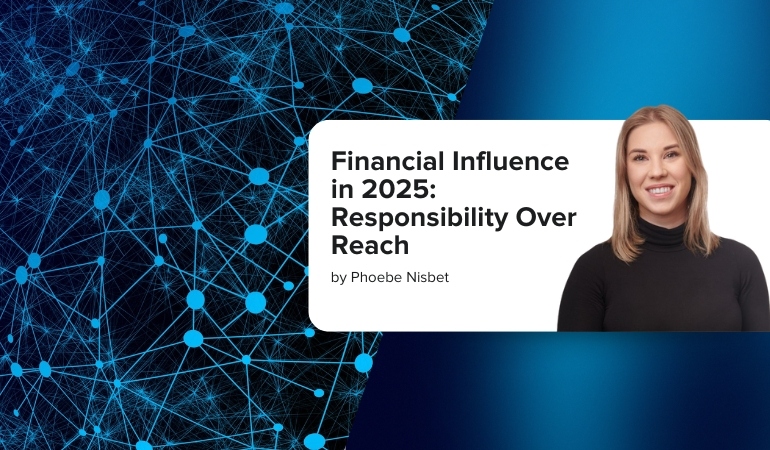In recent years, financial influencers, more commonly known as ‘finfluencers’, have become a staple of social media. Just a year ago, their future was up for debate. And I’ll be honest: I was skeptical. I still am. But regardless of where you stand, one thing is clear - finfluencers aren’t going anywhere. Their growing presence demands attention, and more importantly, collaboration. Trusted financial institutions have a unique role to play in helping debunk misinformation and raising the bar for financial literacy.
From Novelty to Norm
Finfluencers gained traction by making finance feel accessible, especially to younger, digital-native audiences. They filled a gap traditional institutions had been slow to address, offering financial content that felt conversational, relevant, and easy to digest.
But as their reach has grown, so has scrutiny from regulators, brands, and increasingly, consumers. And rightly so. The next question becomes: can financial institutions partner with finfluencers while upholding credibility and compliance?
A Shifting Landscape
There’s a growing understanding that people trust people more than they trust institutions. Finfluencers are effective not just because of what they say, but how they say it. They use platforms that feel familiar and their content is direct, informal and easy to digest. This makes them valuable partners for brands, but also a potential risk.
The challenge is that not every finfluencer is equipped to offer financial guidance, in fact many have little to no formal background in finance. Their strength lies in communication, not always in qualification. That’s where the responsibility shifts to the brands working with them.
We’re seeing a shift away from ignoring the presence of influencers and toward structured, strategic relationships controlled by trusted financial institutions. Brands are now more focused on careful vetting and detailed briefs. The aim is to guide the content from the start, ensuring it's accurate, aligned with compliance standards, and adds genuine value to the audience.
More Than Just Regulation
Recent updates from the Financial Conduct Authority (FCA) in the UK have made expectations clearer. Financial promotions must be fair, clear, and not misleading. Content aimed at younger or less experienced investors needs to be especially transparent. High-risk products require prominent risk warnings. Finfluencers promoting financial products without authorisation are breaking the law.
But regulation is only part of the picture. The bigger issue, and opportunity, lies in how the financial services industry responds.
Misinformation online doesn’t correct itself. And when it comes to finance, the cost of getting things wrong can be significant. While regulators are stepping in where necessary, there’s also a growing argument that larger firms should take a more active role in setting the record straight.
The responsibility shouldn’t fall solely on the shoulders of finfluencers, especially when many of them are still learning the sector themselves. The institutions with the knowledge, resources and reach to do better should also do more.
It’s not about broadcasting corporate messages. It’s about meeting people where they are, and offering clear, engaging and accurate information that cuts through the noise. If bad advice is going viral, the solution is not silence, it’s stronger, smarter content from sources that are equipped to provide it.
The Value of Internal Voices
At Indulge, we’ve embraced a strategy built around internal voices, empowering employees to share their insights online and become trusted sources of truth.
We know your experts are busy. That’s why our process is built for efficiency: we interview your subject matter experts and repurpose their insights into multiple formats, ensuring their knowledge reaches wide audiences. It often starts with simple education—helping teams understand how to use platforms like LinkedIn effectively and participate meaningfully in conversations.
The results speak for themselves. It boosts brand trust, builds authenticity, and ensures that qualified voices are contributing to the conversation. When employees share their real-world experience, they do more than inform, they connect.
This shift helps rebalance the online narrative. For every underqualified finfluencer giving questionable advice, there should be a credible financial expert offering clarity, and it doesn’t have to be the CEO. Real insight from real people goes a long way.
Building a Better Dialogue
Social media is no longer a one-way broadcast channel. It’s a space for dialogue. Brands are finding that engaging in honest, even difficult conversations online can actually strengthen trust. Finfluencers, and internal voices, can be an important part of that.
Of course, this only works when supported by robust compliance processes. Involving compliance from the outset not only ensures that content is accurate, it gives brands more freedom to operate with confidence and creativity. It also builds better relationships between teams, where legal and marketing work side by side rather than in opposition.
Moving Forward with Balance
Finfluencers are here to stay. But their role is evolving; from attention-grabbers to educators, from unfiltered opinions to more discerning collaborators. The same evolution applies to the brands that work with them.
There’s a broader responsibility now. Financial institutions, especially larger ones, have the credibility, resources, and reach to make a difference. That doesn’t mean nitpicking every online error. It means providing stronger, smarter content in the right formats and being present where people are looking for answers.
At the end of the day, people buy from people. In finance, where trust is hard-won and easily lost, human connection matters more than ever.
When guided by clarity, care, and a shared sense of responsibility, finfluencers and financial institutions can work together to shape a more informed, confident generation of investors.





